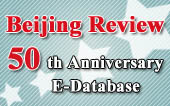| On April 1, the National Museum of China held its first exchange exhibition, the Art of Enlightenment. This exhibition was a joint event hosted with three German museums presenting nearly 600 exhibits that had been preserved for three centuries, including art works such as oil paintings, engravings and sculpture. This is not only the biggest exhibition program between China and Germany up to now, but also the biggest exhibition of the Art of the Enlightenment in the world.
It is the first step the National Museum is taking toward its strategic objective of hosting a series of Chinese and foreign cultural exchange programs following three years' renovation and expansion, and one of the many important missions the new National Museum is expected to undertake.
Since its reopening in March, the National Museum has presented seven exhibitions covering ancient and modern arts and the Chinese history. Houmuwu Tetrapod, a piece exhibited in the bronze art display, is the largest ancient bronze ware known so far. It is a typical masterpiece dating back more than 3,000 years. The newly renovated museum will be China's most comprehensive showpiece of the country's long history.
The renovation and expansion project was launched in March 2007. Based on the former National Museum of Chinese History and the former Museum of the Chinese Revolution, the expanded showcase now covers an area of 191,900 square meters, much larger than its original 65,000 square meters; making it the world's largest museum in terms of space. It can also now accommodate 1.2 million art works. It has 44 exhibition halls ranging from 800 to 1,000 square meters. Because of the renovation, the museum is better equipped with modern and comprehensive facilities, and truly ranks as a world-class museum.
The new National Museum keeps its solemn and grand facade. The museum is designed and situated in such a way as to form a cultural belt together with various other surrounding architecture, with Tiananmen as its core. The museum has also leapt forward in terms of presentation methods, using various modern means such as big screens, video and ultrathin TV to restore as much historical atmosphere as possible and also make the exhibition a dynamic process.
The museum intends to present cultural diversity of the world. While exhibiting a spectacular array of Chinese culture, the museum will also mount foreign shows in the form of exhibitions on loan and exchanges in its permanent Asian, African, European and American rooms. The nation will therefore be provided with the opportunity of appreciating diverse cultures as well.
Chinese museums have undergone three stages of development. At the beginning of the 20th century, when China was in a semi-feudal and semi-colonial social condition, the aim of setting up museums was to enlighten and inspire the Chinese people to strive hard for the survival and development of the nation. So, education naturally became its mission. The first decade after the founding of the People's Republic of China in 1949 marked the second period of development, when museums were constructed and operated using the former Soviet Union model. Museums then were endowed with an over-abundance of political missions. The third stage was from the 1980s to the present. Especially since the 1990s, many museums have begun to improve their quality and equip themselves with modern facilities and operation methods. | 